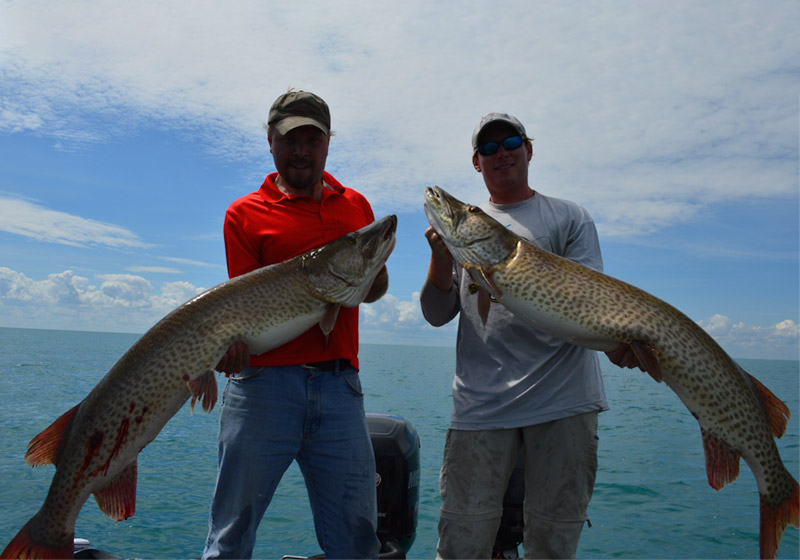Lake St. Clair Fishing Guide Part 2

In the first part of this two part series on Lake St. Clair we talked about how the different changes in the lake over the past 60 years have affected the lake itself, as well as the musky population and forage. In this part we are going to talk about how these changes have affected the fishing on the lake and how, as anglers, you should go about fishing in St. Clair today. It is also important to keep in mind that although this article focuses on Lake St. Clair you can also use any of these concepts on your local lakes when they apply.
As is only appropriate for Lake St. Clair we are going to split up the fishing into two different categories: trolling and casting. First we will talk about trolling on the lake, the changes and what is the best way to go about trolling it now. As most of you are aware, most of the trollers on St. Clair employ a mast planner board system. This allows the anglers to spread out their lines much more effectively then with inline boards, as well as allowing them to troll in much bigger waves and at much higher speeds. That concept remains unchanged on Lake St. Clair and if you are planning to go out to strictly troll, you cannot beat a mast system. On the flip side, one of the areas we do see major changes on trolling St. Clair is in the speeds. In the past, Lake St. Clair used to be extremely easy to troll for one very simple reason, the fish were extremely hungry. Due to the less than desirable amount of forage, the fish were forced to be extremely opportunistic in their feeding. This basically meant that as long as you put a bait over a fish, they would eat it. For this reason the lake developed a high speed trolling method of fishing with most boats doing in the neighborhood of 5 mph if not higher. However, on today’s Lake St. Clair that is rarely the best choice. If you are looking to turn numbers of fish on the lake these high-speed trolling tactics are not a bad choice, especially in the middle of summer when the water is warm. However, most days you will find it very difficult to find quality fish doing these kinds of speeds. Today’s St. Clair monsters generally seem to like baits running in the 3.5 to 4.0 range. In addition to this being my opinion, I spoke with Captain Jason Quintano, a good friend of mine and owner and operator of Grins and Fins Musky Charters. He is also the winner of both the Muskie Bash Classic and the Big Show Shootout, two of the largest trolling tournaments on Lake St. Clair last year. He stated:
"My optimal trolling speeds on Lake St. Clair last year were between 3.4 to 4.0 mph, but generally keep it right around 3.8 mph. This will not only allow you to catch good numbers of muskies but also big fish as well."
It seems that since the fish are so much better fed today they are not forced to simply eat whenever they see food, but rather can choose more when they want to chase something down. In my opinion this is why slowing down and force feeding them a bit more is so successful, especially for the larger smarter fish which tend to be far less suicidal. Having said all of that, do not be afraid to kick up the speed some days in the summer when fishing is tough and you are not getting bites. As you know, the only rule in musky fishing is that there are no rules. The slower speeds are simply a guideline, however you always need to pattern the fish for the day you are on the water.
The last major areas where we see changes are in the baits used for trolling. In the past we saw mainly smaller joined crank baits taking the forefront. However, today this is far from the case. Although joined crankbaits still catch fish on the lake, the majority of the larger fish today are coming on straight crankbaits and mainly on bucktails. Crankbaits such as Muskie Train's MX 6 and Donatos Custom Lures 6 inch Enforcer have been top choices. As for bucktails Spanky's and Double Cowgirls always seem to lead the way. The much cleaner water, in addition to the slower speeds, seem to make the flash of the bucktails and the slower wobble of the straight crank baits perfect for not only big fish but numbers of fish as well. When I asked Jason’s opinion he agreed and said:
"The big fish bait right now on St. Clair is a bucktail. Don’t get me wrong, we do well on crankbaits but bucktails seem to be what’s putting the big fish in the boat day in and day out for us trollers. I prefer to run smaller bucktails in the early season and then as the season progresses the bigger bucktails with double 10’s are always in the set."
Casting
The rather interesting part of casting on Lake St. Clair is that the concept is fairly new. Granted there were a few guys out there casting beyond a decade ago, however for the most part the casting side to the lake is pretty new. Despite the new stature, casting anglers have posted up some monster catches. These big fish catches have given casting massive credibility and attention on St Clair. However due to the Lakes complete lack of any distinguishable structure, casting on Lake St. Clair can appear to be the proverbial needle in a haystack. Despite this, once you get it dialed in, 10 plus fish days are not only achievable, but actually common.
The first major things to look for are the weeds. Lake St. Clair is pretty much completely surrounded with a variety of different weeds. When you are targeting these shallow weeds, less then 7 foot, there are a couple things you need to look for. First of all is cabbage. The lake is full of milfoil, grass and cabbage and all of these weeds can hold fish. However, hands down, the cabbage beds hold the most and biggest fish. Normally a good rule of thumb is to go through these weed beds looking for stretches of cabbage in amongst the weeds, either while fishing or just cruising. Put down waypoints, and then come back to the areas where you have seen good cabbage and fish them heavily. Also, it is important to keep in mind that due to the extremely shallow depth of Lake St. Clair, just because you see a weedline between you and shore does not mean there will not be weeds outside of you, between you and open water, as well. Therefore, always make sure you are looking for additional weed growth on either side of where you are.
The next major structural items you can target on the water are the sand breaks. Although they do not seem all too steep of breaks, generally only 1-2 feet, these sand breaks make up a large contour change in a lake with so little contour to it. In addition, normally on the bottom of the sand breaks you will find a small edge of cabbage. These cabbage edges are almost always loaded with big fish. Luckily for anglers, these sand edges are normally fairly well marked and easy to find on your map or GPS.
Another major structural item to look for is the channel edge. Most of you have probably heard how amazing these deep river channel edges are in the fall. However, I am here to tell you that all of these channel edges hold fish in the summer as well. Once again when fishing these channels be sure to always target areas with good weed edges, preferably cabbage. Also, due to the extremely fast moving current it is often a good idea to try and work baits deeper down the edges. By letting your baits sink down the edge a bit, it will help to get them in front of fish that are lying near bottom. Normally the fish in these channels have been driven down by the current, so if the fish are off the weed edges this tactic will work great.
The last major casting area for anglers to target is open water. I know that open water on a body of water as large as Lake St. Clair's roughly 270,000 acres seems a slightly impossible task, however it is not. When you consider that the two primary forage fish on the lake for muskies are shad and perch, species that spend the majority of their adult life in open water. It only makes sense that these open water areas would be key casting locations. Normally when I am looking for open water areas I am looking for one of three things: baitfish, weeds, or simply muskies. Baitfish on a lake as shallow as this are rather hard to get on a graph below you. Due to the small cone size and spooky nature of the boat, baitfish rarely allow themselves to be seen by your regular sonar. Side imaging, on the other hand, is extremely useful and allows you to see baitfish on either side of you without being over top of them. By using your side imaging you can look for areas on the lake that consistently hold baitfish. The next things to look for in open water are weeds. Rarely are you going to see weeds growing all the way to the surface in the open water areas, 8-12 foot deep generally. However, because the lake is so clear, weeds will normally grow in patches 2-5 foot off the bottom. These weeds almost always hold both numbers of musky and some of the largest fish out there. The last thing you should be looking for, and this goes for any of the tactics discussed above, are muskies. Whenever you see, hook, or catch a musky you should always immediately waypoint it. These fish tend to run in packs and where there is one there are almost always more, even if you cannot see any reason that fish would be there in the first place. So a good rule of thumb is: when you have action from a fish, always waypoint it and then fish that area for a while to see if it was alone or if it had other muskies with it.
Lures
When it comes to casting lures on Lake St. Clair there is one major factor to consider. Are you casting in areas where trollers are? The trollers only use two types of lures: crank baits and bucktails and they can only make the lures go in a straight line. For that reason when I am fishing water that I know a lot of trolling boats go over, I almost never use bucktails or crankbaits, and instead go with lures that I can give a ton of action. In my opinion, there is no better lure for that then a bulldawg. A bulldawg is a casters dream for a lake like St. Clair simply because it allows you to impart so much action, all of which the trollers straight running lures cannot duplicate. Also, it gets down roughly 2 to 5 foot which allows you to both work it over weeds and, when needed, it can get down deeper when you are fishing in open water. I prefer to give my bulldawgs tons of stopping and starting, up-down and left- right action by doing a lot of hard rips with your rod in every direction. It seems in the summer it normally works best to be extremely aggressive with your bulldawgs in order to trigger these fish that have normally seen tons of baits going in a straight line. On the other hand, in early June and the fall, normally long slow pulls work better for the slightly slower metabolic rates of these colder water muskies. Other baits which seem to work well are gliders, such as hellhounds and soft tailed phantoms, in addition to jerk baits like the classic weighted Suick.
When you are casting in the shallow weedy areas of the lake, you will not have to worry about the trollers already giving the muskies a chance to hit their bucktails. For that reason I tend to throw a lot of double cowgirls when fishing these shallow weedy areas. As a bonus, these baits ride perfectly over the high growing weeds making them, easily, the best choice for this type of fishing on St. Clair. I have also found that often speed is a primary trigger when cranking in bucktails on St. Clair and I almost always prefer a high speed reel to trigger strikes.
Lake St. Clair is one of those few lakes that seems to have it all. It is extremely large with a ton of different fish catching options. You can troll, cast or jig and all of these tactics give you a chance at catching great numbers of muskies as well as some monster fish. Not to mention with more then 200,000 muskies in the lake, many of them breaking the 50 inch barrier, there are more than enough fish to make your fishing experience unforgettable.
HOURS
Monday
7:00am - 8:00pm
Tuesday
7:00am - 8:00pm
Wednesday
7:00am - 8:00pm
Thursday
7:00am - 8:00pm
Friday
7:00am - 8:00pm
Sat. & Sun.
7:00am - 8:00pm
Spencer's Angling Adventures
29474 Old North River Road
Harrison Township, MI 48045
(419) 410-0498


